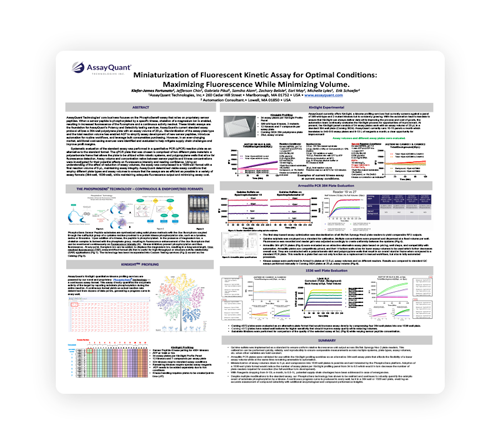What’s New at AssayQuant?
Download the latest posters from AssayQuant, presented at SLAS24 Boston.
Our scientists have been busy showcasing their latest achievements at conferences. In case you’ve missed them, we’ve compiled our latest posters. From the development of new assays, revolutionizing an approach to studying time-dependent inhibitors, and improvements to assay design, each of these posters highlights the ways we continue to improve.
Download the posters to learn more and schedule a 1:1 meeting with our scientific team to answer your questions or discuss further.
Download Our Latest Posters

A Proven Activity-based Workflow for the Identification and Characterization of Time-Dependent Kinase Inhibitors using a Continuous Assay Format
Learn why understanding TDI is important and how we’ve characterized EGFR inhibitors using our established workflow to understand the critical kinetic parameters associated with TDI.

A Novel Sox-based Continuous and Homogeneous Assay for the Discovery of Inhibitors of Inactive and Active AKT
See how we developed a robust, homogeneous assay to simultaneously monitor AKT activation and substrate phosphorylation for the evaluation of inhibitors of active AKT activity and inactive AKT activation.

A Continuous Kinetic Assay to Quantitate Specific Protein Kinase Activity in Unfractionated Cell Lysates
Discover how we selectively quantify kinase enzymatic activity in crude cell or tissue homogenates. Here, we describe a highly selective sensor peptide for ERK1/2, its validation and how we can extend this assay to other kinases of interest.
%20Poster.png)
Evaluation of Capillary-Mediated Vitrification (CMV) as an Alternative to Traditional Cold Temperature Storage for Kinase Assay Reagents
Learn how we are developing the use of vitrification to simplify assay execution by consolidating multiple temperature sensitive components onto a single scaffold without sacrificing assay performance.

Practical Evaluation of Time-Dependent Inhibition Kinetics Through Small-Volume Size-Exclusion Chromatography
When studying time-dependent inhibitors, a technique known as a “jump dilution” is used to determine the mechanism of irreversibility; however, it faces significant challenges when characterizing highly potent inhibitors. See how we are overcoming these challenges with a novel combination of SEC-facilitated compound clearance and continuous kinetic monitoring to capture reversibility.

Miniaturization of Fluorescent Kinetic Assay for Optimal Conditions: Maximizing Fluorescence While Minimizing Volume
Discover how we are evolving our assays through miniaturization of standard assay conditions. Through these efforts, we demonstrate that PhosphoSens technology continues to robustly quantify substrate phosphorylation in 384 well or 1536 well plates.

Three Different Liquid Handling Systems to Achieve Flexibility and Scalability in Compound Screening against 400+ Protein Kinases
See how we designed and implemented three automation systems to guarantee that high-quality data collection, analysis, and reporting are completed with accuracy and efficiency.